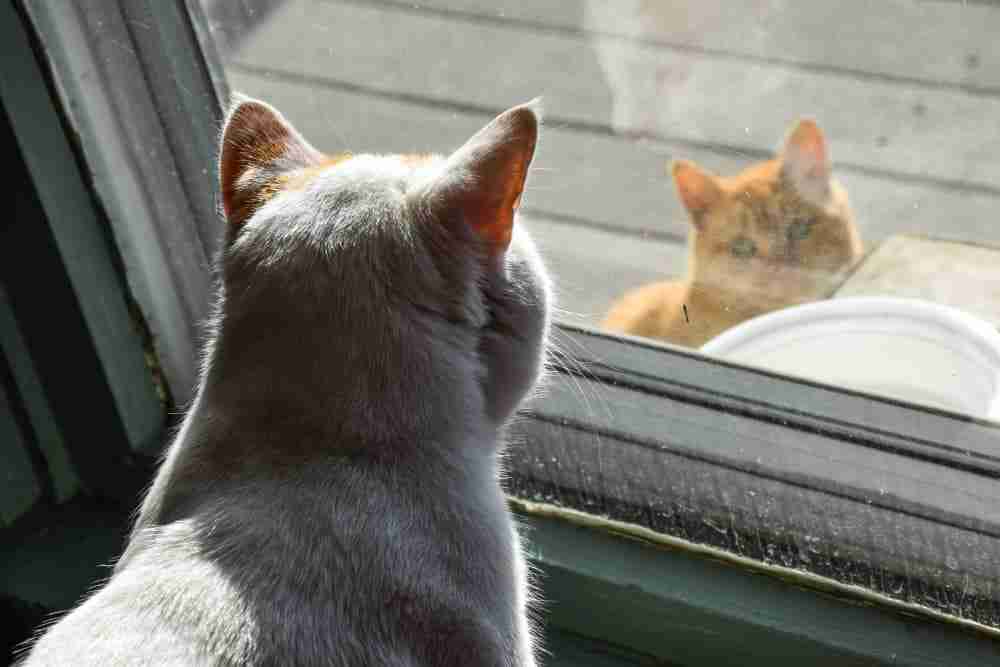You turn out the lights to go to bed, and that’s when you hear the growling coming from the yard. It turns out some feral cats decided to make the crawlspace under your porch their home for the winter – cute, well, kind of.
- Why Do Cats Spray?
- How Do I Detect Spraying?
- How To Stop Stray Cats from Spraying outside Your home? – 15 Tactics Outlined.
- Wash Down Your Porch
- Use A Sound Deterrent
- Use A Water Spray Deterrent
- Use A Commercial Deterrent Spray
- Use a homemade deterrent spray
- Use Planters With Off Putting Plants That Cats Don’t Like
- Spread coffee grinds, pepper, lemon, or orange peels
- Get Strays Removed Humanely
- Keep Bins Unaccessible
- Remove Furniture Used As A Scratching Area
- Block Up Openings
- Build Gravel Borders Around Your Porch
- Get A Yard Dog
- Provide An Alternative Marking Area
- Plant Catnip To Lure Them Away
- Wrapping up – Never Approach a Stray Cat
Having a stray cat move into your yard might seem cute and cuddly, but strays have some issues. They don’t have the same domestication as housecats, and they can have wild temperaments. Males and females don’t receive any neutering or spaying, and they have all their glands intact, along with a raging hormone system.
Therefore, a feral cat is more like a wild animal than a pet. If you walk out onto your porch, you might notice that it smells like cat pee.
Why Do Cats Spray?
Community, feral and stray cats like to mark their territory, especially if there are dogs or other cats around. Spraying smells terrible, and the cat will keep on marking as long as they hang out on your property.
Cats have a hyper sense of smell, and they communicate through a special language of scents. Typically, a housecat spreads its fragrance on you by rubbing its cheeks and the corners of its mouth on you.
These areas of the cat’s head have scent glands they use to mark you as their owner (or, in the case of most cats, marking you as their pet).
However, while strays also use these glands, they also spray to mark territory. The spray has a pungent smell, and it contains other communication biochemicals like pheromones.
These biochemical markers help the cat leave a calling card to any other animal that wanders into its territory.

How Do I Detect Spraying?
When stray cats spray around your porch, they back up to it while standing up and lift their tail. As they spray, it’s common for strays to twitch their tail, although veterinary science has no idea why.
It’s fairly easy to identify this spray visually against freshly painted surfaces with lighter colors.
However, if you have varnished, sealed, or stained wood, it will make it challenging to identify the affected area with a visual inspection. How to find cat pee? You may need to use a UV light. UV torches are pretty cheap these days and, when shone in the dark, will show cat pee up as bright yellow traces.
How To Stop Stray Cats from Spraying outside Your home? – 15 Tactics Outlined.
If you have a stray lurking around your property at night, it’s possible to keep them from spraying your porch. Do you want to know how to stop cats from spraying outside your home? Here are a few tips to get the kitty’s to move onto another area where they won’t cause a fuss or a smell.
Wash Down Your Porch
First off, clean down your porch. Use a water hose and do a thorough scrub down.
You want to use a detergent and really go at it. Don’t be tempted to use bleach. Bleach can damage your deck timber and some cats are attracted to the smell of bleach.
The idea is to wipe the slate clean. Eliminate the stray’s territorial marking so the urge to reinforce the mark is reduced. Also, you are looking to reduce scent communication. The cats are using your porch as a message drop zone. Cut out the messages from getting through – like cutting the phone line.
Additionally, you need a clean slate so you can accentuate the following tactics and effectively monitor their impact.
Use A Sound Deterrent
If you want an easy tactic to start with, this is it. Go get yourself a sonic cat deterrent device.
These are solar-powered, operate via a motion detector that can usually cover an area up to 60m2, and emit a sound that cannot be heard by humans but will put cats (and other animals) off from the area.
The latest versions also emit a flash of red light that is not visible to the human eye. You can use them night and day and they usually come with weatherproof cases – all for circa $30.
These modern deterrents may be all you need – lots of people have great success with them!
Use A Water Spray Deterrent
You can either arm yourself and the kids with soakers and water pistols and basically stake out your porch or you can go slightly higher-tech and get a motion detector water sprayer set up. Either way, cats don’t like being blasted with water so a water spray can be a great deterrent.
Motion detector water sprays tend to be slightly more expensive than the sound deterrents and need a water supply – but a soaked kitty doesn’t come back!
Highly effective if set up correctly and will keep stray cats off your porch or any area you choose to cover. Most will fire out a spray to 30 feet and can be adjusted for direction and coverage.
Use A Commercial Deterrent Spray
What can I spray on my porch to keep cats away? You could opt for an odor-based deterrent spray. These are often for both indoor and outdoor use and consist of natural products that cats are known to dislike.
Nature’s Mace Cat Mace is one such spray. It contains a veritable who’s who of cat repellents – cinnamon, castor oil, peppermint oil, lemongrass oil, garlic, soap, vinegar, vanilla, etc.
The basic premise is that cats have a sense of smell that is 16x greater than ours and some scents are just overpoweringly strong enough to make them vacate the area.
You can spray this stuff all over the place and it is safe for humans, vegetation, and animals are biodegradable and generally harmless apart from its overpowering noxious smell – if you are a cat with a nose 16x stronger than a humans!
Depending on the bottle size you are looking at spending $20 up for this stuff.
Use a homemade deterrent spray
Like the idea of a deterrent spray and want to start straight away? How about using some simple ingredients from around your home to produce an instant homemade cat deterrent spray?
Cats don’t like some fairly mundane smells – objectively, if your nose was 16x stronger these mundane smells might be pretty awful to you as well!

The first ingredient you can use is any citrus fruit – you can squeeze the juice of oranges and lemons, steep the fruit in hot water – either option will work. Mix the juice with some water and use the liquid as a spray.
Cats dislike the citrus odor and should be put off from areas you have liberally sprayed! You can also use this method to keep a cat out of a room without doors.
What about vinegar? Do you have a bottle of vinegar in your home? Vinegar can be watered down and sprayed about liberally without harming plants, staining timber, or being dangerous to anything in the environment – but it will act as a cat deterrent!
The great thing about vinegar is that it will also act as a natural disinfectant cleaning up areas where cats may have sprayed previously so vinegar is a great option straight off the bat after you have washed down your porch – disinfectant and deterrent!
Use Planters With Off Putting Plants That Cats Don’t Like

You will often see cats chewing on plants or rubbing against certain plants – some plants are safe for cats – but some plants produce an odor that we humans enjoy but cats hate.
If you have a problem with cats on your porch it can be smart to put some of these plants right in the spots you want the cat to vacate. Obviously, you want the cat to get a smell of these plants and decide they are better off hanging out somewhere else!
So which plants can you use? Try these humans friendly cat deterrent plants in pots and planters around your deck and garden if you want to make your porch and garden unpopular with cats :
Lavender
Pelargonium Geraniums
Lemon Thyme
Rosemary
Citronella
Curry Plant
Pennyroyal
Spread coffee grinds, pepper, lemon, or orange peels
Maintaining the odor-related theme, you could spread items around your porch and property to keep cats away.
Cats are known to dislike the odor of coffee grounds, orange peel, lemon peel, and pepper.
If you want to prevent cats from getting to your porch or hanging around your yard in general then spreading these items around the borders will put them off. And they are biodegradable, and act as compost so they are an all-round win!
The idea is not necessarily to drop them on your porch but just to make your property generally uninteresting for cats.
Obviously, once you start putting this stuff down you are going to have to be fairly diligent and keep adding overtime to keep the deterrent fresh as it’s the odor that is doing the job and you want peak odor at all times!
Get Strays Removed Humanely
If you have a stray problem in your neighborhood and you find they are increasingly visiting your property then it may be time to call in a no-kill shelter with a view to trapping, neutering, and releasing the feral cats.
Releasing? Absolutely…the point here is that neutering brings an end to all the mating instincts in a feral cat colony so you get less territorial behavior and behaviors associated with mating like spraying.
Sure, the cats are still around but their behavior changes and the colony they form doesn’t keep on growing but stabilizes and reduces naturally with time. If you just call in a shelter to have the cats destroyed you likely won’t catch them all and the colony will always grow.
Keep Bins Unaccessible
Do you have a trash bin or rather a food source on your porch? This could be the reason your local strays are visiting – you are providing a food source for them.
The solution here is to remove the bin to a different location or secure the bin so it is unaccessible to local animals. You may have foxes or raccoons opening bins which then also bring the cats in.
Find a way to lock down bins if you can’t relocate them altogether!
Remove Furniture Used As A Scratching Area

Cats love to scratch. Scratching is another way of marking territory but is also a way of encouraging claws to shed and renew.
When cats scratch they look for any object they can run both front paws along at once. This means chair legs are going to be used, decking or porch verticals might be used and doorway mats are going to be targeted for this behavior.
So, the quick answer is to remove the furniture and mats from your porch to discourage cats from visiting.
But, if you are really smart you might consider placing scratching posts away from your porch to remove the need for local cats to visit your porch and give them somewhere more attractive to visit – in an area of your choosing.
Block Up Openings
Strays may be on your porch seeking shelter. Do you have access to the underside of your home via the porch?
Block openings that strays may be using for access to shelter. Blocking off access to shelter spots may move the local cats on to seek other areas and you might find your porch is not such a drop in zone and doesn’t suffer from cats spraying in the area.
If money was no object you could potentially provide shelter away from your home whilst blocking access – again a tactic to encourage cats away from where they currently hang out by bribing them with a better option.
Build Gravel Borders Around Your Porch
This option is potentially expensive but surprisingly successful.
Cats don’t like walking on gravel or sharp stone.
Putting a 3ft border of gravel around your porch and making your approach path gravel or loose stone might be all you need to make your porch completely unapproachable to local cats.
Get A Yard Dog
If you are a dog lover it could be time to indulge and get yourself a dog who can run free in your yard.
Their presence physically and their own marking of the vicinity will probably be enough to keep local cats away.
The only problem is that owning a dog comes with all sorts of issues of its own – and then they are probably going to bark at any cats they see and potentially upset the neighborhood peace in their own rite.
But hey, if you are a dog person, why not?

Provide An Alternative Marking Area
So you have used all sorts of deterrents and used a load of tactics and think you have the problem sorted? And maybe that will be enough – but sometimes you need to make the alternative option attractive to prevent the old problem from re-emerging later.
Maybe all you need to do to get stray cats to spray elsewhere is to provide them with a better option?
Cats like a nice loose material to use for marking, covering, and general toileting behavior. It may prove worthwhile to create an area of your yard that is purpose-made for such activity.
I am talking about a nice patch of ground that has finely tilled earth that can be dug and turned by cats with ease. They will spot such ground and be attracted to use it – in doing so your porch problem may disappear. It isn’t ideal but it is another tactic…
Plant Catnip To Lure Them Away
On the topic of providing attractions away from your porch, we all know that loads of cats go mad for catnip mint?
Well, they do, so it would make sense to plant some as far away from your porch as possible to try to tempt them away from that area, right?
Catnip is a cheap plant that grows like mad, so grow it in a bucket and bury the bucket at ground level to prevent the stuff from spreading everywhere or you will have all the cats visiting!
Wrapping up – Never Approach a Stray Cat
It’s surprising to learn that male cats can still spray, even after being neutered. However, unfixed cats tend to spray a lot more.
Female cats also mark their territory with urine, regardless of if spayed or not. In most cases of spraying around your home, male cats are probably to blame.
They do it to attract females and mark territory. Males are also far more territorial than females, and they tend to spray much more when looking for a mate.
If you have a female cat at home, males might visit your porch at night to mark it in an attempt to impress your feline.
If you catch a stray cat spraying, leave it alone. Some of these animals have very bad temperaments, and they may even attack you. Being scratched by a feral cat requires a trip to the emergency room to clean up your wounds.
